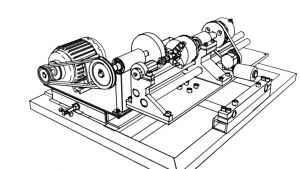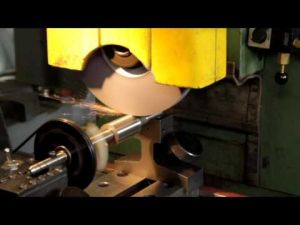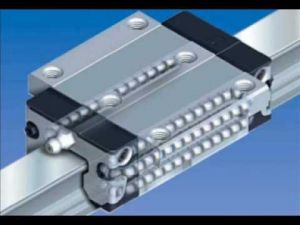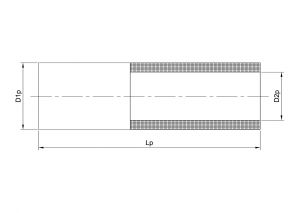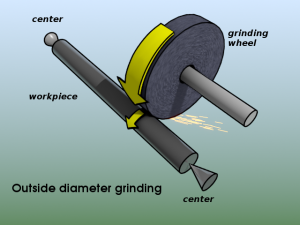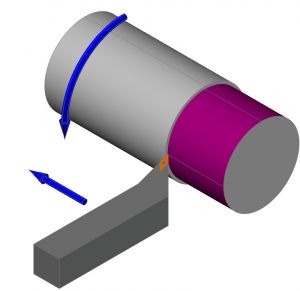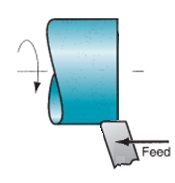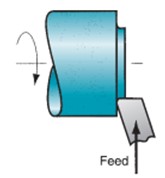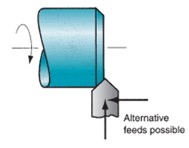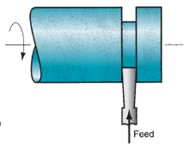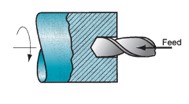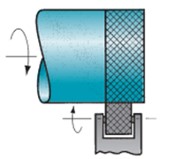Difference between revisions of "Cylindrical Grinding machine"
Inddigital (talk | contribs) ((by SublimeText.Mediawiker)) |
Inddigital (talk | contribs) ((by SublimeText.Mediawiker)) |
||
| Line 90: | Line 90: | ||
**** Speed of the piece in grinding: 0.22m/s | **** Speed of the piece in grinding: 0.22m/s | ||
**** Feed in grinding: 17.5mm/rev | **** Feed in grinding: 17.5mm/rev | ||
**** Depth of pass in grinding: 0. | **** Depth of pass in grinding: 0.01mm | ||
**** Rotational speed of abrasive wheel: 5662rpm | **** Rotational speed of abrasive wheel: 5662rpm | ||
**** Rotational speed of the piece in grinding: 133rpm | **** Rotational speed of the piece in grinding: 133rpm | ||
*** Performance | *** Performance | ||
**** Time of one pass in grinding: 6.4s | **** Time of one pass in grinding: 6.4s | ||
**** Number of passes in grinding: | **** Number of passes in grinding: 650 | ||
**** Time per piece in grinding: | **** Time per piece in grinding: 69min | ||
**** Weekly production: | **** Weekly production: 144 pieces/week | ||
*** Tooling cost | *** Tooling cost | ||
**** Quantity of pieces per abrasive wheel: | **** Quantity of pieces per abrasive wheel: 632 | ||
**** Cost of abrasive wheels to make 1000 pieces: | **** Cost of abrasive wheels to make 1000 pieces: 17USD | ||
*** Mechanical load | *** Mechanical load | ||
**** Absorbed power in grinding: | **** Absorbed power in grinding: 1.22HP | ||
**** Grinding torque : | **** Grinding torque : 1.5N-m | ||
**** Force transmitted in grinding : | **** Force transmitted in grinding : 1174N | ||
** Turning process [[File:wikipedia_Laengs-Rund-Drehen.jpg|thumb]] | ** Turning process [[File:wikipedia_Laengs-Rund-Drehen.jpg|thumb]] | ||
*** Characteristics of the tool used | *** Characteristics of the tool used | ||
| Line 128: | Line 128: | ||
**** Force transmitted in turning : 2384N | **** Force transmitted in turning : 2384N | ||
** Conclusions: | ** Conclusions: | ||
*** Production performance drops significantly in the case of manufacturing the parts through the grinding process, achieving | *** Production performance drops significantly in the case of manufacturing the parts through the grinding process, achieving 15% of what can be produced by turning in the same period of time, this is due to the fact that the depth of past has a relationship of 3 to 100 with respect to both scenarios. | ||
*** When reviewing costs per tooling, the grinding process is far preferred over turning, grinding wheels were estimated for a wear ratio of 80 (volumetric ratio of wear to metal removed). | *** When reviewing costs per tooling, the grinding process is far preferred over turning, grinding wheels were estimated for a wear ratio of 80 (volumetric ratio of wear to metal removed). | ||
*** Regarding the mechanical load resulting from machining, it could be determined that it increases in a proportion of 1:3 in the case of turning, so the respective forecasts must be taken when designing the bed, which It will support loads in the order of 300kgf, assuming a safety factor of 30%. | *** Regarding the mechanical load resulting from machining, it could be determined that it increases in a proportion of 1:3 in the case of turning, so the respective forecasts must be taken when designing the bed, which It will support loads in the order of 300kgf, assuming a safety factor of 30%. | ||
Revision as of 05:29, 4 February 2023
|
Cylindrical Grinding machine Basic Data Category: Lathes Keywords: lathe, grinding machine, roughing, spindle, workshop, speed, feed, depth of cut, bed, tailstock, chuck, turret, grinding wheel License: CC BY-SA 4.0 Organization: OHO Project status: Active Certification status: In process Technical documentation Maturity of the project: prototype
Contains PDF-drawings: Yes CAD files are editable: Yes Assembly instructions are published: Yes Bill of materials is published: Yes
yes yes
|
|
Description
Technical documentation
Project development | |
Based on the DIN 2221 standard, among others, OHO has established a series of stages in which the satisfactory completion of this project was carried out
1 Feasibility study
Operation Compliance Comments Yes For parts that require the use of center point or steady rest, the non-interference of moving parts must be verified. Yes The radius of the part must be less than or equal to the useful width of the abrasive wheel. Yes The abrasive turning mechanism must be able to rotate and move obliquely on the cross slide (tool post grinder). Yes The abrasive turning mechanism must be able to rotate and move obliquely on the cross slide (tool post grinder). Yes Requires the use of smaller diameter accessories, for example, diamond-tipped tools. | |
+ General Reviews 

